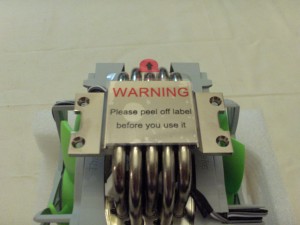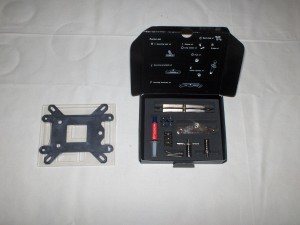A Closer Look at the Installation Process
The included backplate is a fiber-reinforced polymer that’s light and stiff. It is also double-sided for compatibility; one side is mounted for AMD Athlon, Phenom, or any of your other AM2/3 chips, and the other fits Intel’s LGA775, 1155, 1156, and the 1366. We test-fitted the Jing to our test rig, detailed below. For testing purposes, every component was running at stock speeds.
| Processor | AMD Phenom II 970 Black edition |
| Motherboard | Asus Crosshair 3 Formula |
| RAM | four gigabytes of Gale PC1333 DDR3 |
| Graphics | ATI 6890 direct from AMD |
| Enclosure | NZXT Phantom |
| Power Supply | NZXT 1kW PSU (80+ certified, minimizing this source of ambient heat) |
The first thing we discovered upon examining the heat sink was that there was “some assembly required.” The mounting hardware was packaged in the small parts kit instead of being screwed into the base of the cooler. This might have been done to protect the extra-quiet fans from damage should the thumbscrews rattle around too much in shipping. We noticed a protective plastic film over the thermal interface surface. Be sure to remove this before installation. Underneath it, we found one of the best-polished heat sink surfaces that we at TechwareLabs have been privileged to install. It was about as smooth as the average mirror. Further examination of the heat sink itself revealed that the two fans are not identical, even though they seem identical. Fortunately, they can only be mounted one way, ensuring that the two fans are not fighting to the death while your CPU stews in its own juices. Lastly, the integrated rheostat fan-speed controls were a nice touch, but their placement looked questionable. We will return to this during the installation process to make sure the placement actually works.
 |
 |
| Thermaltake’s mounting kit is nicely presented, laid out, and organized. | Thermal interface surface showing the protective plastic sheet mentioned above. |

You must be logged in to post a comment.